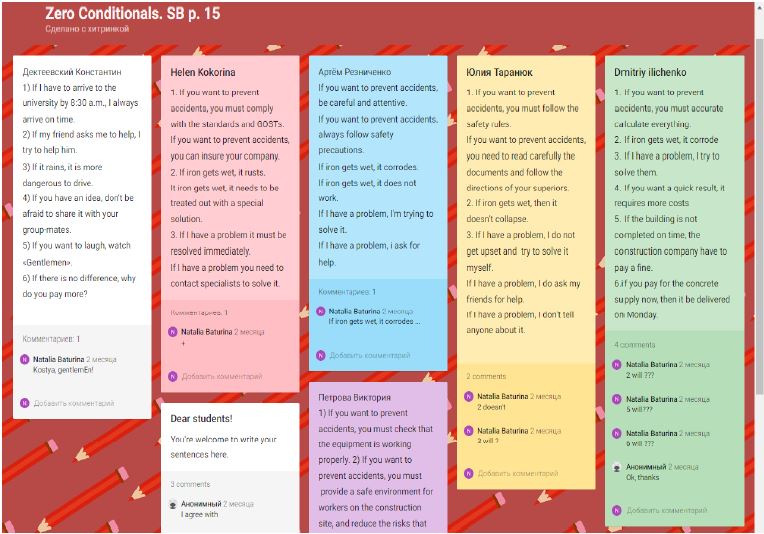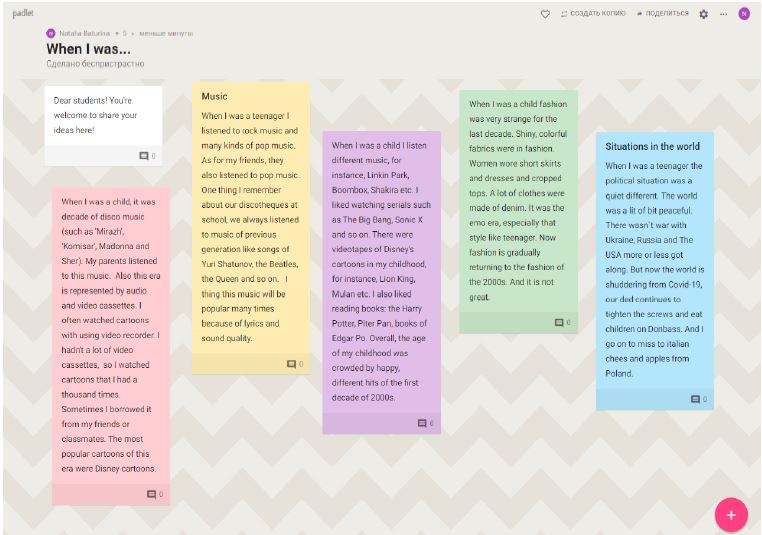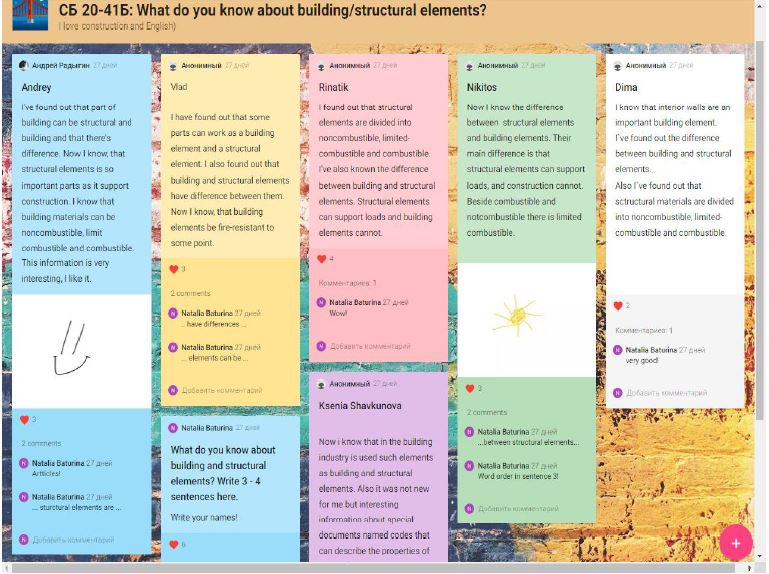PADLET WEB PLATFORM AS AN EFFECTIVE MEANS IN TEACHING TECHNICAL UNIVERSITY STUDENT
DOI: https://doi.org/10.23670/IRJ.2022.118.4.035
ВЕБ-ПЛАТФОРМА PADLET КАК ЭФФЕКТИВНОЕ СРЕДСТВО В ОБУЧЕНИИ СТУДЕНТА ТЕХНИЧЕСКОГО УНИВЕРСИТЕТА
Научная статья
Батунова И.В.1, *, Батурина Н.В.2, Руковишников Ю.С.3
1 ORCID: 0000-0002-1825-0097;
2 ORCID: 0000-0002-9960-8520;
3 ORCID: 0000-0003-3326-0960;
1, 2, 3 Сибирский федеральный университет, Красноярск, Россия
* Корреспондирующий автор (familiya_irina[at]mail.ru)
Аннотация
В начале своей профессиональной карьеры современные бакалавры, специалисты и магистры должны показывать хорошо развитые навыки анализа, сопоставления и (само)корректировки, а также способность применять эти навыки в своей независимой работе. Веб-платформы значительно расширили возможности приобретения этих навыков в процессе взаимодействия в виртуальной среде.
В данной статье рассматриваются некоторые возможности по использованию современных образовательных платформ в процессе обучения студентов как в аудитории, так и на дистанционном обучении или в электронном образовании. Авторы доказывают значимость применения новой обучающей технологии, используя в качестве примера веб-платформу «Padlet», работающую онлайн в качестве «виртуальной доски объявлений». В статье представлены характеристики виртуальной доски «Padlet», а также дано описание её основных функций, позволяющих решить ряд образовательных задач. Авторы предлагают несколько примеров практического использования «Padlet» во время занятий по английскому языку в техническом университете. Авторы приходят к выводу, что интеграция современных образовательных платформ подобных «Padlet» и традиционного занятия по английскому языку способствует формированию высокого уровня мотивации студентов и их интереса к занятиям, что положительно сказывается на развитии их познавательной и умственной деятельности.
Ключевые слова: ИКТ, смешанное обучение, Padlet, языковые навыки, активное обучение, онлайн обучение, рефлексивные навыки, образовательная платформа, информационная культура.
PADLET WEB PLATFORM AS AN EFFECTIVE MEANS IN TEACHING TECHNICAL UNIVERSITY STUDENT
Batunova I.V.1, *, Baturina N.V.2, Rukovishnikov Yu.S.3
1 ORCID: 0000-0002-1825-0097;
2 ORCID: 0000-0002-9960-8520;
3 ORCID: 0000-0003-3326-0960;
1, 2, 3 Siberian Federal University, Krasnoyarsk, Russia
* Corresponding author (familiya_irina[at]mail.ru)
Abstract
When starting their professional activities, modern bachelors, specialists and masters have to demonstrate well developed skills of analysis, comparison and (self)correction, as well as the ability to apply the skills in their independent work. Web platforms significantly expand the opportunities of acquiring these skills in the process of interaction in a virtual environment.
This article discusses some possible options for the modern educational platforms usage in the process of teaching students both face to face in the classroom and in a distance learning or e-learning. The authors prove the relevance of a new teaching technology application using a real-time web-platform with bulletin boards – «Padlet» – as an example. A description of «Padlet» features as well as a description of the main functions that allow solving a number of educational tasks are given. Several examples of the practical «Padlet» using at the English classes for students of a technical university are provided. The authors have come to the conclusion that the integration of modern online platforms (similar to «Padlet») into a traditional English class contributes to the formation of a high level of students’ motivation and interest, which has a positive effect on the development of their cognitive and mental activity.
Keywords: ICT, blended learning, Padlet, language skills, active learning, online learning, reflection skills, educational platform, information culture.
Introduction
The modern education system, which is based on the classical model, is a new system with its new principles and new content, since the problems of various learning technologies using in the educational process have become more acute because of the widespread pandemic distance learning situation. Our modern educational environment is formed on the basis of virtual culture, distance communication and new requirements for all participants of the educational process. Obviously, the virtual world of both a modern student and a teacher has become much wider and more diverse than it used to be. In this paper, we are describing and speculating on a technology that involves active learning, and which includes a smart phone in the educational process.
Active learning improves students’ academic achievement in a variety of disciplines [1]. This is due to the active participation of students in the learning process, which not only improves their academic success, but also increases their satisfaction, motivation and well-being [2]. However, even when active learning is achieved during the classes, there may be different levels of its benefits provided to students. Often only a few students participate in the activity or speak up, thereby participating better and benefiting more from the learning than other students. Decreased student engagement interferes with the achievement of high results, especially in mass courses [3]. Therefore, it is important to use such educational tools that not only promote active learning, but also provide equal opportunities for everyone to participate.
Materials and methods
Due to the fact that the tools for learning and teaching foreign languages are being constantly updated, a large variety of online platforms and mobile applications allows teachers to plan classes in such a way that all university student learning features are taken into account.
In turn, it is impossible to imagine a classroom without a whiteboard. Online learning has also adopted this classical learning feature, but improved it many times over. A good example of such a tool that is quite competitive in the internet is the «Padlet» bulletin board.
«Padlet» is a shareware online tool. It allows you to share notes, links, photos and videos. The teacher and students do not need to download a special application and / or regularly update its settings. «Padlet» is compatible with almost any modern device – desktop computers, laptops, tablets and smart phones, regardless of their operating system. The only obligatory technical demand for using this web platform is access to the internet. Notes or entries made on this platform can be saved as images, pdf /csv files, spreadsheets or embedded in a blog or a website. Also, all entries made by students on this web platform can be anonymous which, to some extent, can be beneficial too.
To optimize the process of a lesson planning, a variety of functions of this web platform can be used by a teacher, which allows a lesson to contain different types of activities. During the process of a lesson planning, the teacher needs to choose the right «tool» of the web platform, which best suits the content of the lesson and the IT literacy of students.
Having worked with the «Padlet» web platform, the authors are able to present the advantages of this online tool which are the following:
- Availability and flexibility of the bulletin board. To start working with the board at the lesson, the teacher has to send a link which s/he has created in advance.
- Free of charge using possibility.
- User-friendly interface of the web platform: a pleasant design, user-friendly settings, language choosing possibilities, different levels of privacy and authorship. The settings allow the teacher to change not only purely decorative functions (e. g. the background picture, font, bulletin board appearance, etc.), but also the filtering function, for example, content approval and automatic replacement of insults and taboo words.
- The ability to use «Padlet» to work with students throughout the entire process of teaching: during the presentation of new material, during its practice, production and test. Also, the tool can be integrated for teaching vocabulary, grammar, pronunciation, for the development of both productive and receptive skills.
- The anonymous use of the bulletin board provides educators with the opportunity to collect relatively honest feedback on various aspects of teaching.
- «Padlet» can also be used as a way to organize educational, extracurricular and scientific activities both for students and the learning environment in general: notes, links, etc. can make up a useful student’s «library» where s\he has an opportunity to organize its content differently, for example, by topic.
- The development of common (UK-4 «Communication» where a student is able to carry out business communication orally and in writing in the state language of the Russian Federation and foreign language(s)) and general professional (OPK-2 «Information Culture» where a student is able to process, analyze and present information in professional activities using computer technologies) competencies. The competences are given according to the Federal state educational standards for higher education.
- Absence of any long-term training on the web platform use.
- Creating a friendly, comfortable atmosphere for students in the learning process with the help of communication tools familiar to them – smart phones and laptops.
- The teacher is able to track the most vulnerable places in certain language aspects (vocabulary, grammar) simultaneously for a group of students and correct or change the learning strategy using additional tasks.
- A good possibility for students’ reflection and analysis of their own language level.
However, the authors’ experience in using the «Padlet» web platform, as well as research by other experts shown below, have revealed several shortcomings and limitations:
- The platform is shareware. After reaching the limit for creating new boards, there are three possible options: to delete the existing boards, archive them, or switch to the «Padlet Pro» with a monthly / annual payment.
- Anonymity of students. If desired, students can also register on the web platform. Otherwise, the student needs to write down his/her name.
- Students have no access to the bulletin boards which have been archived.
- «Padlet» incorporation in the educational process must be carried out wisely and students should understand why they have to use this tool and what benefits can it provide. The teacher must set clear students’ goals.
- Some research suggests that using of «Padlet» «doesn’t encourage the development of students’ critical skills» [4] because students don’t feel like looking for errors and mistakes in their group mates’ entries.
- A small number of theoretical studies and practical applications on the use of «Padlet» in general.
However, the authors believe that the advantages and positive effects of the «Padlet» web platform outweigh the disadvantages mentioned. We would like to demonstrate its capabilities on several examples. Bachelor students of the first and second years of studying have a four months language practice on the web platform. All students are of non-linguistic specialties of various institutes in Siberian Federal University. The language level according to CEFR is mostly elementary and pre-intermediate. Figure 1 presents a bulletin board interface with several folders already created. The authors recommend that you immediately name the boards by groups / topics / tasks to simplify the navigation later.
Figures 2 – 4 show the examples of the board using during the various stages of learning. Figure 2 demonstrates the practice of conditionals. Students either complete the given sentences or write their own; this exercise is aimed at the mixed level groups. The teacher can immediately see all the results of the work being carried out and provide feedback.
Students can also comment on each other’s work. In Figure 3 the aim of the task is to think about the past before learning new topic. At the beginning of the lesson, every student has an opportunity, firstly, to guess the author of the text, and secondly, to get acquainted with each other’s experience and express an opinion about coincidences / discrepancies in preferences and views. Figure 4 presents the students’ answers to check the understanding of the watched video on the topic. Students have to write some facts from the video that they didn’t know before.
Fig. 1 – A bulletin board interface
Fig. 2 – The practice of conditionals
Fig. 3 – Students’ comments
Fig. 4 – Students’ answers
Discussion
Current changes in education have created an environment in which learning is no longer limited to being an individual activity. Collaborative active learning, which is a branch of connectivism, is a well-established pedagogical approach that offers learners a variety of benefits, including new knowledge acquisition, self-regulatory behavior, learner autonomy, and positive interdependence [5]. This is one of the educational approaches used to achieve active learning through engagement. Collaboration creates an effective learning environment by creating learning relationships [6]. It also demonstrates benefits such as student engagement while supporting learning a variety of disciplines [7] and improving students’ exam performance [8]. Several digital tools have been shown to promote student engagement through collaborative experiences. For instance, digital tools including MediaWiki and Google Docs have been used by information management students for effective collaborative knowledge construction [9], while the iPad has improved collaborative learning in physics student study sessions [10] and encouraged nursing students to participate in learning activities [11].
Results
Based on the practical examples presented, the authors believe that the «Padlet» web platform is beneficial to both parties. It helps to increase the students’ motivation, and also to increase the effectiveness of teaching, since the teacher has an opportunity to adjust the lesson plan, the tasks type and teaching methods best of the educational process «here and now». Of course, working with this web platform implies the competent incorporating of the «Padlet» board in the educational process so that the use of this technology seems to be meaningful for students. The teacher must be aware of why it is necessary to use the «Padlet» and set clear students’ aims.
Conclusion
Nevertheless, the use of ICT, in general, provides plenty of opportunities for improving the additional general developmental program and optimizing pedagogical activity: the possibility of individualization and differentiation of learning, remote control, as well as the ability to attract students with high cognitive motivation and high mental abilities to prepare and present some parts of the lesson with the help of modern technologies. It is obvious that the use of ICT is justified, as it expands the educational process, makes it more interesting, effective and optimal, thereby increasing the students’ cognitive activity and learning motivation, creating an atmosphere of collaboration favorable for learning. ICT allows students to achieve better results both in academic studying and in self developing.
| Конфликт интересов Не указан. | Conflict of Interest None declared. |
Список литературы / References
- Freeman, S. Active learning increases student performance in science, engineering, and mathematics / S. Freeman, et al. // Proceedings of the National Academy of Sciences of the United States of America, vol. 111, no. 23, pp. 8410–8415. DOI: 10.1073/pnas.1319030111
- Bernard, J. S. Student engagement: a principle-based concept analysis / J. S. Bernard // International Journal of Nursing Education Scholarship, vol. 12, no. 1, pp. 111–121. DOI: 10.1515/ijnes-2014-0058
- Young, S. A reflexive evaluation of technology-enhanced learning / S. Young, H. Nichols // Research in Learning Technology, vol. 25. 2017. DOI: 10.25304/rlt.v25.1998
- Deni A. Padlet as an Educational Tool: Pedagogical Considerations and Lessons Learnt / Ann Deni, Zainor Izat Zainal // Conference: 10th International Conference on Education Technology and Computers.2018. DOI:10.1145/3290511.3290512
- Scager, K. Collaborative learning in higher education: evoking positive interdependence / K. Scager, et al. // CBE life Sciences Education, vol. 15, no. 4, pp.1–9. DOI: 10.1187/cbe.16-07-0219
- Cotterill, S. T. Tearing up the page: re-thinking the development of effective learning environments in higher education / S. T. Cotterill, // Innovations in Education and Teaching International, vol. 52, no. 4, pp. 403–413. DOI: 10.1080/14703297.2013.862174
- Donaldson, L. Collaborative tools to enhance engagement in a blended learning master’s programme / L. Donaldson, et al. // All Ireland Journal of Teaching and Learning in Higher Education, vol. 9, no. 1, pp.2921–29220. DOI: 10779/rsci.10774577.v1
- DuretD. Collaborative learning with PeerWise / D. Duret et al. // Research in Learning Technology, vol. 26. 2018. DOI: 10.25304/rlt.v26.1979
- Chu, S. Using online collaborative tools for groups to co-construct knowledge / S. Chu, D. Kennedy // Online Information Review, vol. 35, no. 4, pp.581–597. DOI: 10.1108/14684521111161945
- van der Ventel, B.The role of the iPad in collaborative learning in a large-enrollment first-year physics module / B. van der Ventel, et al. // Physics Education, vol. 51, no. 4, p. 045017. DOI: 10.1088/0031-9120/51/4/045017
- Davies, M. Using the Apple iPad to facilitate student-led group work and seminar presentation / M. Davies, // Nurse Education in Practice, vol. 14, no. 4, pp. 363–367. DOI: 10.1016/j.nepr.2014.01.006
- Cooner, T. S. Creating opportunities for students in large cohorts to reflect in and on practice: lessons learnt from a formative evaluation of students’ experiences of a technology-enhanced blended learning design / T. S. Cooner // BJET, vol. 41, pp. 271–286. DOI: 10.1111/j.1467-8535.2009.00933.x




